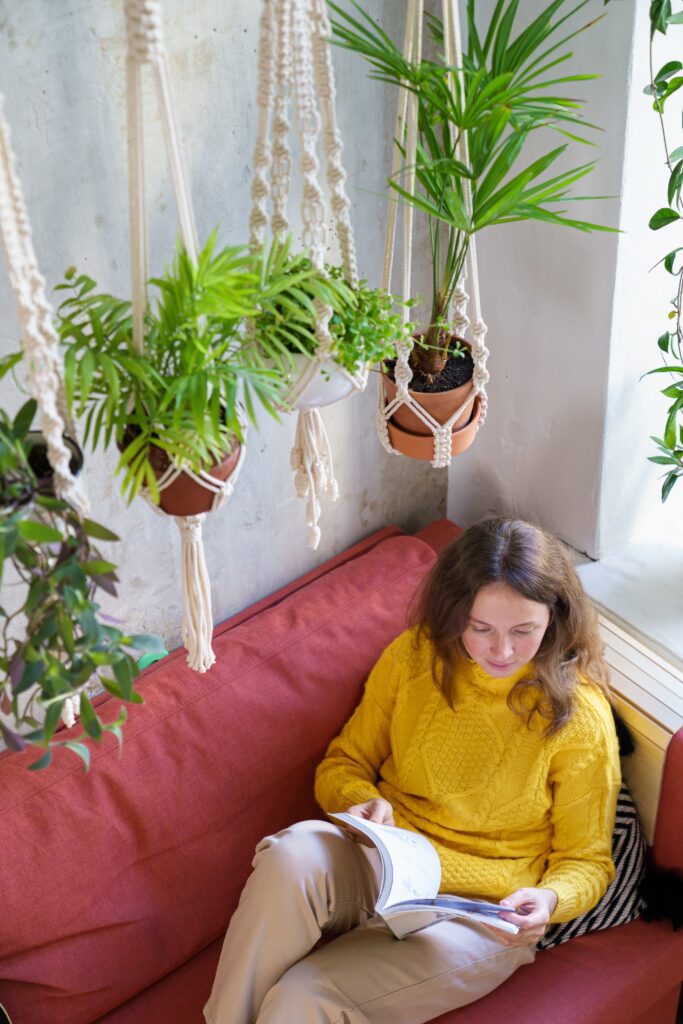Hanging plants indoors is a great way to add greenery to your space while saving surface area. Here’s how you can hang your plants indoors:
1. Choose the Right Plants
- Light Requirements: Select plants that thrive in the available light. Common hanging plants include pothos, spider plants, ivy, and ferns.
- Size: Consider the size and growth habit of the plant. Ensure it won’t outgrow its space too quickly.
2. Select the Hanging Method
- Hanging Planters: Use hanging baskets or pots designed for indoor use.
- Macrame Hangers: These stylish holders can be used to suspend pots from the ceiling or wall.
- Wall Hooks or Brackets: Install sturdy hooks or brackets on walls to support the weight of the plant.
- Tension Rods or Curtain Rods: For small, lightweight plants, you can use tension rods between window frames or curtain rods.
- S Hooks or Plant Rings: Attach these to existing structures like shelving or ceiling beams to hang plants.
3. Choose the Right Spot
- Light: Place your plants in a spot where they will receive the right amount of sunlight, whether it’s direct, indirect, or low light.
- Accessibility: Ensure you can easily water and care for the plants.
- Spacing: Leave enough room between plants to allow for airflow and growth.
4. Install Ceiling or Wall Hooks
- Ceiling Hooks:
- Locate a Stud: Use a stud finder to locate a stud in the ceiling for maximum support.
- Drill a Pilot Hole: Drill a small hole where you want to place the hook.
- Insert the Hook: Screw a ceiling hook into the pilot hole. Ensure it’s secure.
- Hang the Planter: Attach your hanging planter to the hook.
- Wall Hooks or Brackets:
- Mark the Spot: Determine where you want to place the hook or bracket.
- Drill a Pilot Hole: Drill a hole into the wall. If you’re not drilling into a stud, use a wall anchor for additional support.
- Install the Hook/Bracket: Screw the hook or bracket into place.
- Hang the Plant: Attach your plant hanger to the hook or bracket.
5. Use Suction Cup Hangers (for Windows)
- These can be used for lightweight plants or small terrariums. Ensure the suction cups are strong and rated to hold the weight.
6. Macrame or Rope Hangers
- Install a Hook: Place a ceiling hook where you want to hang the plant.
- Thread the Hanger: Place the pot inside the macrame hanger or tie ropes around the pot.
- Attach to the Hook: Securely hang the macrame or rope from the ceiling hook.
7. Repurpose Furniture
- Ladders: Lean a ladder against the wall and use the rungs to hang plants.
- Shelving Units: Hang small pots from the edges of shelves using hooks or brackets.
8. Caring for Hanging Plants
- Watering: Be careful when watering to avoid spills. Consider taking the plants down to water them or using a watering can with a long spout.
- Drainage: Ensure pots have proper drainage. Place saucers under pots or use pots with internal reservoirs to catch excess water.
- Pruning: Regularly prune your plants to keep them healthy and prevent overgrowth.
By following these steps, you can beautifully and securely hang your plants indoors, adding life and vibrancy to your space. Kiefer Landscaping has all the plants you could need and a large variety of products to help decorate indoors!
